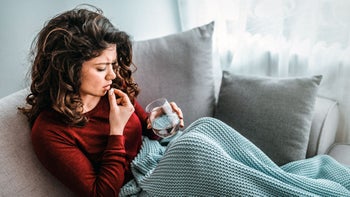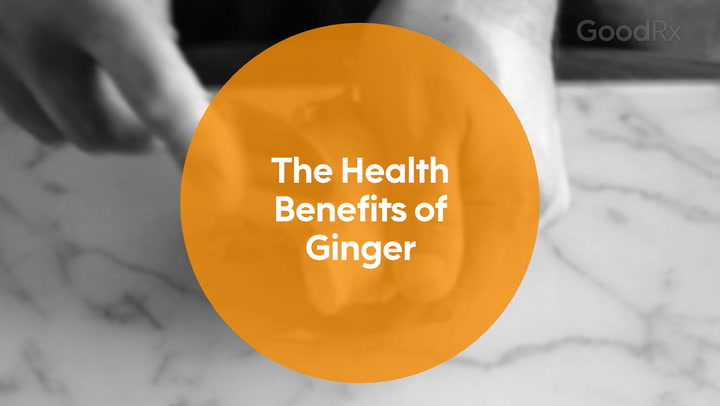
What Helps With Period Cramps? 5 Over-the-Counter Medications, Plus Home Remedies
Key takeaways:
You can help get rid of period cramps with at-home remedies, like a heat pack, exercise, stretching, hydration, and quality sleep. For some, aromatherapy and nutritious foods can help, too.
Over-the-counter (OTC) medications, like ibuprofen (Advil, Motrin) and naproxen (Aleve), help treat period cramps by lowering inflammation. Acetaminophen (Tylenol) works by blocking pain receptors in the brain.
Other products, like Midol and Pamprin, may have a pain reliever combined with other medications. These are a good option if you have other symptoms, like bloating, along with menstrual cramps.
Table of contents

Period pain is common. Most women have been dealing with it since their teenage years — but that doesn’t mean it gets any easier as the years go by.
More than half of those who get periods report pain and cramping for 1 to 2 days per cycle. Usually, menstrual cramps happen just before or right when your period starts. For most, they feel like muscle cramps or a pain in the lower belly or back. But period cramps often come with other symptoms, like bloating, diarrhea, nausea, headache, or fatigue.
If you’re one of the many people dealing with painful periods every month, you’ll likely have your own tips and strategies for coping. Exercise, nutritious foods, hydration, and sleep can all help. And simple at-home remedies, like a heating pad or a warm bath, can offer some relief, too.
If those remedies aren’t enough, over-the-counter (OTC) medications can be useful. They can bring speedy relief in the moment and prevent period pains from building.
Medicine for period cramps: Can over-the-counter medications help?
OTC pain medications are a helpful way to manage and prevent painful periods without a prescription or a visit to a healthcare provider.
You can take one for immediate relief if other approaches haven’t worked. Or you can take an OTC pain reliever before your period starts. There’s some evidence that starting pain relievers 1 to 2 days before your period starts can help prevent cramps from getting too intense in the first place. The American College of Obstetricians and Gynecologists (ACOG) also recommends continuing to take these until day 2 or 3 of bleeding.
OTC medications work to ease period cramps in a few different ways:
NSAIDs (nonsteroidal anti-inflammatory drugs), like ibuprofen (Advil, Motrin) and naproxen (Aleve), work by slowing down the production of prostaglandins, chemicals involved in inflammation and pain. Fewer prostaglandins mean less pain.
Others, like acetaminophen (Tylenol), directly block pain receptors.
Some OTC medications, like Midol or Pamprin, contain a combination of ingredients to help target other period symptoms as well, like bloating and fatigue.
To help you sort through these options, we’ll review our top five recommendations and explain how and why they work as well as how to take them. But if you aren't sure if these medications are safe for you, it's best to first check in with your healthcare provider or pharmacist.
1. Ibuprofen (Advil, Motrin)
Ibuprofen (Advil, Motrin) is a NSAID that can relieve pain caused by cramps. NSAIDs help block the production of prostaglandins in your body. So they target the cause of menstrual cramps.
For menstrual cramps, a usual dose of ibuprofen is 2 pills (400 mg total) by mouth every 6 hours, as needed. Do not take more than 1,200 mg of OTC ibuprofen per day.
2. Naproxen (Aleve)
Naproxen (Aleve) is another NSAID that treats cramps. It works similarly to ibuprofen, treating the cause of the pain.
For menstrual cramps, you can take 1 tablet (220 mg) by mouth every 8 to 12 hours, as needed. Do not take more than 3 tablets (660 mg) of OTC naproxen per day.
3. Acetaminophen (Tylenol)
Acetaminophen (Tylenol) is also a pain reliever, but it’s not an NSAID. It blocks chemicals in the brain that cause pain. Research suggests that NSAIDs may work better than acetaminophen for menstrual cramps. But acetaminophen is still an effective pain reliever for many people. And you can take it with an NSAID too, if needed.
A typical dose of acetaminophen is 2 tablets (650 mg) by mouth every 4 to 6 hours, as needed. For more severe pain, you can take up to 2 tablets (1,000 mg) every 6 hours, as needed.
In general, most adults and children ages 12 and older shouldn’t take more than 4,000 mg per day.
Some groups of people need lower doses. Double check what dose is right for you if you’re not sure. Too much acetaminophen can increase your risk of liver damage. And some other medications include acetaminophen, so make sure to check the labels of any other products you’re using.
4. Midol
Midol is a well-known brand that makes several medications. Midol products are marketed specifically for period symptoms. Many pharmacies stock them in the same aisles as pads and tampons, instead of in the pain-relief section. Generic versions of Midol that contain the same ingredients are also available.
In addition to pain, Midol products contain other ingredients, which they claim treat other symptoms:
Pyrilamine: an antihistamine that may reduce bloating
Caffeine: can help with fatigue and possibly bloating
Pamabrom: a diuretic (water pill) that helps you pee and may also help with bloating
Here’s a breakdown of different Midol products and what 1 caplet contains:
Midol Complete: 500 mg acetaminophen, 60 mg caffeine, and 15 mg pyrilamine maleate
Midol Complete Caffeine Free: 500 mg acetaminophen, 25 mg pamabrom, and 15 mg pyrilamine maleate
Midol Bloat Relief: 50 mg pamabrom
Midol Long Lasting Relief: 650 mg acetaminophen
The dose of Midol depends on the ingredients. But many Midol products recommend taking 2 caplets by mouth every 6 or 8 hours. They also typically warn not to take more than 6 caplets per day. Carefully read the product’s OTC drug facts label to see which ingredients it contains and how to take it.
5. Pamprin
Pamprin is another brand that makes medication products specifically targeted to period symptoms. Pamprin uses many of the same ingredients we discussed above, but it also includes aspirin (another type of NSAID) for pain relief.
One tablet of these pamprin products include:
Pamprin Multi-Symptom: 500 mg acetaminophen, 25 mg pamabrom, and 15 mg pyrilamine maleate
Pamprin Max Pain + Energy: 250 mg acetaminophen, 250 mg aspirin, and 65 mg caffeine
The directions are the same for both Pamprin products: 2 caplets by mouth every 6 hours. Do not take more than 8 caplets per day.
Keep in mind that people younger than age 19 should avoid aspirin. Giving aspirin to adolescents and young adults can cause a serious condition called Reye’s syndrome. So Pamprin Max Pain + Energy should only be used in people ages 19 and older.
How to choose the best over-the-counter period cramp medicine for you?
Since there are so many OTC products available, you might be wondering how to choose the best for you. This depends on your symptoms and the side effects you want to avoid.
If you have only menstrual cramps, then you may not need a combination product. You may opt for an individual pain reliever, such as ibuprofen, naproxen, or acetaminophen. If you’re looking to take the lowest number of pills per day, naproxen might be the right choice, as it lasts longer than other OTC pain relievers.
A combination product may be better if your cramps occur along with other symptoms, like bloating of fatigue. This way, you can treat all your symptoms with a single product.
Some combination products contain caffeine. This is the same caffeine that’s in caffeinated drinks, like coffee and tea. So it may keep you awake if you take it too close to bedtime. But other products contain an antihistamine, which can cause drowsiness. So keep that in mind if you’re looking for a product that you can take during the day.
Home remedies to get rid of period cramps
Whether or not you decide to treat your period pains with OTC medications, you can also try some of these natural treatments for immediate relief:
Heat: Take a hot bath, or put a heating pad on your belly. Heat therapy is a great way to quickly ease period pains.
Stretching: Stretching exercises that target the belly and pelvic muscles may be as effective as some OTC medications. For example, gentle yoga poses, like “cat-cow” movements, can help ease your pain within minutes.
Exercise: It might feel like the last thing you want to do, but try a light walk, jog, swim, cycle, yoga, or pilates practice. Exercise can help prevent and treat menstrual cramps.
Orgasm: Again, this may not be top of mind for you at this point in your cycle, but hear us out. Vaginal stimulation — either with a partner or on your own — can ease feelings of pain, at least temporarily. And when stimulation leads to orgasm, the pain-relieving effect may be even more powerful.
Aromatherapy: There’s some evidence that aromatherapy can help get rid of period cramps. Lavender may be especially effective.
Massage therapy: Pamper yourself with a massage, since it’s been shown to help relieve period cramps.
Preventing period cramps
It helps to get ahead of painful periods — before they build. After all, for many people, menstrual cramps happen very regularly.
As we’ve seen, taking OTC medications at the start of your period can help keep period pains from becoming too intense. But you have some other non-medication options, too.
Here are some prevention strategies:
Eat nutritious foods. Focus on fresh, whole, unprocessed foods like fruits, vegetables, fish, whole grains, and olive oil. Anti-inflammatory foods rich in vitamins and minerals may help ease painful periods, but the research isn’t all there yet. Try to avoid foods high in unhealthy fats, sugar, and salt at all times — but especially during your period.
Drink plenty of water. When your body loses blood (like during a period), it also loses fluid volume. Staying hydrated with water and herbal teas can help replace these losses and prevent some of the symptoms of painful periods.
Get a good night’s rest. Bad sleep has been linked to worse menstrual cramps. This may be in part because it’s harder to sleep well when you have period pain. But quality sleep has been shown to reduce chronic pain, so sleep may help ease the pain of periods, too.
Consider hormonal birth control. Hormonal birth control is often used to help prevent painful periods. While results of studies have been inconclusive, there’s evidence that it can be very effective if you have period cramps caused by endometriosis.
When should you see a healthcare provider for menstrual cramps?
If OTC treatments and home remedies haven’t relieved your painful periods, you may need some professional help. Sometimes painful periods can be a sign of an underlying health condition.
Reach out to your healthcare provider if you have painful periods and experience any of the following:
Pain with sex
Pain with peeing or stooling
Heavy bleeding with blood clots during your period
Frequent bleeding in between your periods
Worsening pelvic pain
Fever
You may need an evaluation to look for an underlying cause of your symptoms. While period cramps are very common, they can sometimes be a sign of medical conditions, like:
Endometriosis
Uterine fibroids or cysts
Abnormal pregnancy or miscarriage
Depending on the cause, your healthcare provider may recommend trying prescription medication, birth control, or treatments other than medication.
The bottom line
Painful periods can range from bothersome to so painful that they get in the way of your day-to-day routines. Depending on your symptoms, simple at-home strategies and lifestyle changes can help you cope. But when that’s not enough, over-the-counter medications can help prevent symptoms and relieve them when they come.
Why trust our experts?



References
American College of Obstetricians and Gynecologists. (2022). Dysmenorrhea: Painful periods.
American College of Obstetricians and Gynecologists. (2022). Painful periods.
Bakhtshirin, F., et al. (2015). The effect of aromatherapy massage with lavender oil on severity of primary dysmenorrhea in Arsanjan students. Iranian Journal of Nursing and Midwifery Research.
DailyMed. (n.d.). Midol.
Finan, P. H., et al. (2013). The association of sleep and pain: An update and a path forward. The Journal of Pain.
Focus Consumer Healthcare, LLC. (2020). Pamprin multi-symptom maximum strength- acetaminophen, pamabrom, pyrilamine maleate tablet [package insert]. DailyMed.
Focus Consumer Healthcare, LLC. (2023). Pamprin max menstrual pain relief- acetaminophen and aspirin and caffeine tablet, film coated [package insert]. DailyMed.
Jeon, B., et al. (2023). Menstrual disturbances and its association with sleep disturbances: a systematic review. BioMed Central Women's Health.
Jo, J., et al. (2018). Heat therapy for primary dysmenorrhea: A systematic review and meta-analysis of its effects on pain relief and quality of life. Scientific Reports.
Marjoribanks, J., et al. (2015). Nonsteroidal anti‐inflammatory drugs for dysmenorrhoea. The Cochrane Database of Systematic Reviews.
Motahari-Tabari, N., et al. (2017). Comparison of the effect of stretching exercises and mefenamic acid on the reduction of pain and menstruation characteristics in primary dysmenorrhea: A randomized clinical trial. Oman Medical Journal.
Nationwide Children’s Hospital. (2014). Yoga exercises and menstrual cramps.
Özgül, S., et al. (2023). The effects of connective tissue manipulation in primary dysmenorrhea: A randomized placebo-controlled study. Reproductive Sciences.
Ricciotti, E., et al. (2011). Prostaglandins and inflammation. Arteriosclerosis, Thrombosis, and Vascular Biology.
Torkan, B., et al. (2021). The role of water intake in the severity of pain and menstrual distress among females suffering from primary dysmenorrhea: A semi-experimental study. BioMed Central Women's Health.
U.S. Food and Drug Administration. (2015). OTC drug facts label.
Whipple, B., et al. (1985). Elevation of pain threshold by vaginal stimulation in women. Pain.
Wong, C. L., et al. (2009). Oral contraceptive pill for primary dysmenorrhoea. The Cochrane Database of Systematic Reviews.
















